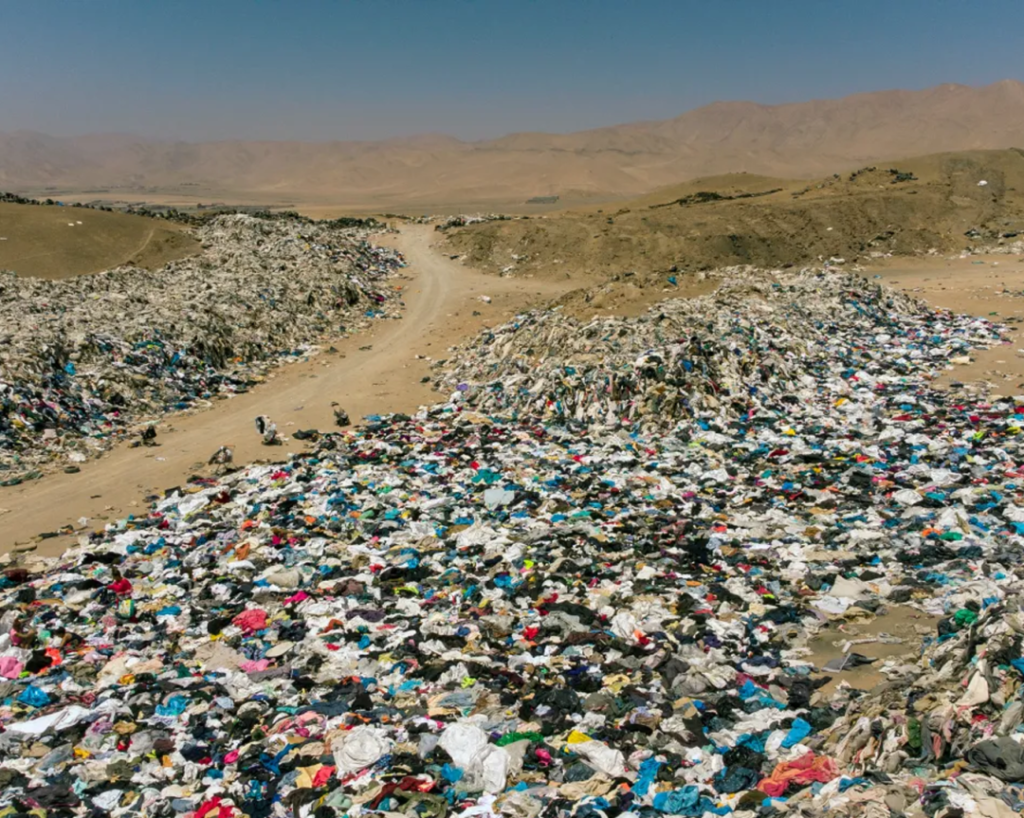Satellite Image Confirms Massive Clothes Pile in Chile’s Atacama Desert
Chile’s Atacama Desert is the driest place on Earth and the largest landfill for so-called “fast fashion” clothes left on store shelves. In this desert, huge hills have been formed in recent years, which are not made of sand but of T-shirts, skirts, and jeans arriving at this strange dump from all over the world. The area is also known as the graveyard of fast fashion. It is estimated that over 60,000 tons of unsold clothing in the US and Europe ends up in the driest desert on the planet.


“Fast fashion” and hyper-consumerism
In the “fast fashion” world, trends change rapidly in clothes, shoes, and accessories. The stores renew the merchandise every week, not in two seasons but in 52 micro-seasons, making the number of clothes and accessories produced dizzying. “Fast fashion” is, in a sense, the rapid absorption of all ideas from the catwalk directly into the stores.
Global clothing consumption has skyrocketed in recent years, fueled by so-called “fast fashion” companies. Since 2000, global production of ready-to-wear has doubled. And the average consumer in the West buys 60% more clothes than 15 years ago.
The main characteristics of these clothes are cheap materials, cheap labour, low cost, and big profits for the shops. When the previous trend “dies”, it usually ends up in the trash. Of course, the materials used in production are also a burden: toxic materials, low quality with dangerous chemicals, are some of the most economical, so the cost remains low. Internationally, it is estimated that “fast fashion” creates 92 million tons of textile waste each year.
According to a UN report, “fast fashion” uses unimaginable amounts of water. It takes around 7,000 litres for a pair of jeans, enough to last one person for seven years – while at the same time, deaths are increasing worldwide from a lack of clean drinking water. UNCTAD estimates that the fashion industry uses 93 billion cubic meters of water a year to satisfy the thirst of 5 million people.
Chile’s Atacama Desert: An ecological disaster
The Atacama Desert (Desierto de Atacama) is in northern Chile. It is an arid plain consisting of basins of salt, sand, and dry lava, stretching from the Andes to the Pacific Ocean. It is 15 million years old and 100 times drier than the second driest area on Earth, Death Valley in California, USA. It holds the world record for the longest drought, as a period of 400 years without rain was recorded until 1971.
Its total area is 181,300 square kilometres, and the fast fashion clothing dump is now so large that it is visible from space. A satellite image shows how large the dump is now compared to the neighbouring city of Iquique, which has a population of 191,468. The Atacama landfill, located a mile from Iquique’s most run-down districts, has generated so much waste that the UΝ has labelled the site an “environmental and social emergency” for the planet.
“The satellite image that we ordered of the clothes pile in Chile’s Atacama Desert puts things into perspective. The size of the pile and the pollution it’s causing is visible from space, making it clear that there is a need for change in the fashion industry. Our mission to make Earth observation data easy and transparent is vital to identifying and addressing problems like this one. With our web and mobile apps, anyone can access satellite imagery to confirm stories and see the world from a new perspective,” notes SkyFi, which captured the satellite images.
“At SkyFi, we are on a mission to easily access Earth observation (EO) data. One use case for the data is to confirm stories told on the Internet and for this reason, we have captured an image of this pile of clothes from space, revealing the true scale of the problem. The 50 cm resolution image, which is classified as Very High Resolution, was taken using satellite imagery, and it shows how big the pile is compared to the city at the bottom of the picture”.


Looking for solutions
As the problem grows in the Atacama Desert, solutions are being sought that could limit the further expansion of the landfill. Efforts are being made to implement a new legislative framework in Chile that will limit uncontrolled clothing imports, to impose penalties on those who commit illegalities.
At the same time, a more effective control mechanism is needed. Similar dumps of fast fashion clothing exist today in other parts of the world, such as Africa. The solution proposed by the environmental organizations is to change the consumer trend of the time and not to change our wardrobe too quickly by keeping and wearing our clothes for longer.



